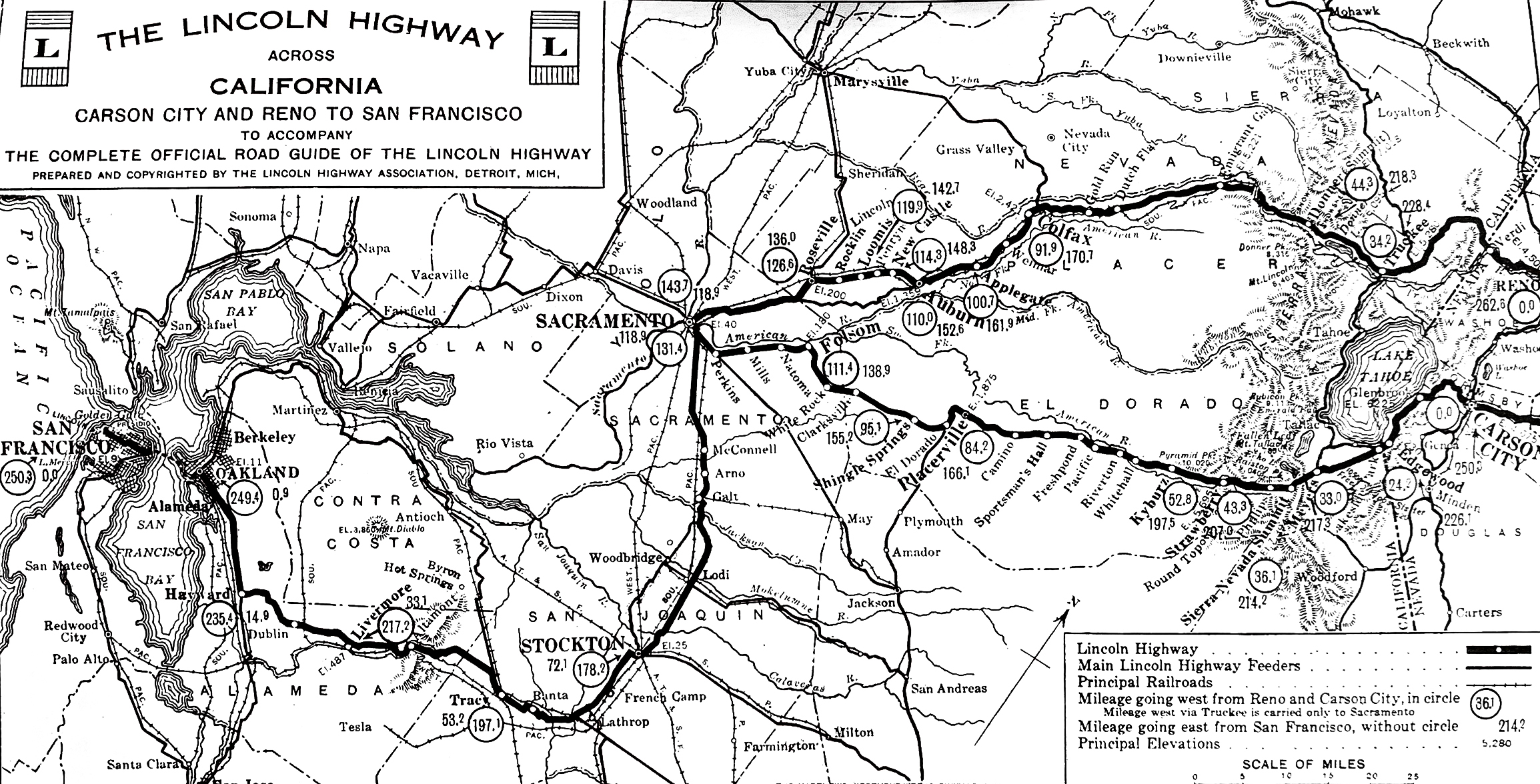A Complete official Road Guide of the Lincoln Highway Fifth Edition 1924
Lincoln Highway Association, reprint by Patrice Press
538 pages. Available from the Lincoln Highway Association’s Lincoln Highway Trading Post (LHTP.com).
This is a fun book that’s been sitting on the shelves of the DSHS for some years. Unless you are planning a cross country trip following the Lincoln Highway’s 1924 route (pieces of the route changed over the years) you’re not going to want to read the whole thing. It’s not until you get to page 193 that the actual route and guide starts. In the guide the traveler gets the transcontinental route broken up into thirty-three segments and each segment broken up into listing of the cities and towns along the way. In each listing there are the mileage, road conditions, and information about the location: tourist information, local businesses, history, etc. The guide is interspersed with interesting drives like how to get to Yosemite, lots of ads, and pictures (including some of Donner Summit). So perusing the pages is looking at life in 1924 traveling America.
“The book is not presented as a final and authoritative statement covering every phase of activity and every particular of existing conditions to be found upon the Lincoln Highway, but is offered as a reliable reference covering distances, accommodations, scenic and historical points of interest, equipment, expense and other data.”
At the end of the book section thirty-three is about the Reno to Sacramento route via Donner Summit. Donner Lake had a post office called Gelatt and was a summer resort. You can see the entry here. There follows a summary of the Donner Party,
“Standing by this monument in the glorious sunshine of a summer day, it is impossible to realize what it must have meant to those emigrants, after so many months of exhausting travel across desert and plain, to gaze at the tremendous barrier before them, already half hidden in the approaching storm, and to know, that if they could only cross this last mountain range, the fertile valleys of California lay but a short distance beyond.”
Donner Lake is described along with the “green forests and immense walls of granite rocks rising to great heights…” “Leave the car and walk down to the shore of this beautiful lake and observe the wonderful scene.” “A more beautiful locality can hardly be imagined than this on the shore of Donner Lake, and the tourist feels well repaid for all the possible hardships of his drive when he finally camps at this spot.” This shows the good taste of the1924 travelers.
“Summit” is next on the itinerary. It had a population of 50, one “general business,” the railroad, the express company, and a telegraph. “Good camping and fishing. Unsurpassed scenery.” Again, the good taste of 1924.
The first 193 pages are also full of ads and pictures, but also various articles about the Lincoln Highway, Lincoln Highway luminaries, the Pony Express, the Overland Stage, what emigrants in the old days should have carried with them, signage, Lincoln Highway “seedling miles,” Lincoln Highway history, and even how to ship your car back home after one way across the continent.
There are interesting facts as well. In1913 there were about 150 transcontinental automobiles; in 1923 there were, “conservatively,” between twenty and twenty five thousand. Where it took sixty days to the cross the continent in 1913 in an automobile, by 1923 it took only thirty with “pleasure parties” taking ordinary, unhurried progress. “Twenty days is an easy drive for anyone.” Apparently there were different writers for different sections and they didn’t always communicate. Twenty days meant driving seven hours per days averaging 18 MPH. The cost of a transcontinental trip was affordable, not more than $5 per day per passenger. The included everything except tires and accidents. California speed limits were 35 mph in the open contry, twenty mph in residential sections, and fifteen at intersections.
There are also hints for travelers, “Don’t’ wait until your gasoline is almost gone before filling up… “Don’t carry loaded firearms… Don’t wear new shoes…”

Advice for travelers from the Official Guide to the Lincoln Highway 1924
Don’t wait until your gasoline is almost gone before filling up. There might be a delay, or it might not be obtainable at the next point you figured on.
Don’t allow your canteen… to be other than full of fresh water.
Don’t allow the car to be without food of some sort any time west of Salt Lake City. You might break down late in the day and have to wait a number of hours until the next tourist comes along.
Don't fail to have warm clothing in the outfit. At night the high altitudes are cold, even in summer, and the dry air is penetrating.
Don't carry loaded firearms in the car. Nothing of this kind is in the least necessary except for sport, anyhow.
Don't fail to put out your camp fire when leaving.
Don't forget the colored goggles. In driving west you face the sun all afternoon, and the glare is hard on the eyes.
Don't forget the camphor ice. The dry air of the west will crack your lips and fingers without it.
Don't build a big fire for cooking. The smaller the better.
Don't ford water without first wading through it.
Don't drink alkali water. Serious internal cramps result. You can quickly tell whether water is alkali or not by tasting it. –
Don't wear new shoes.
Don't use brakes on long down grades. Use compression.
Don't park on curves.
Don't pass another car at the top of a hill or on a curve.
Don't stop to cool motor at top of a hill, put car in gear and coast down to cool motor.

